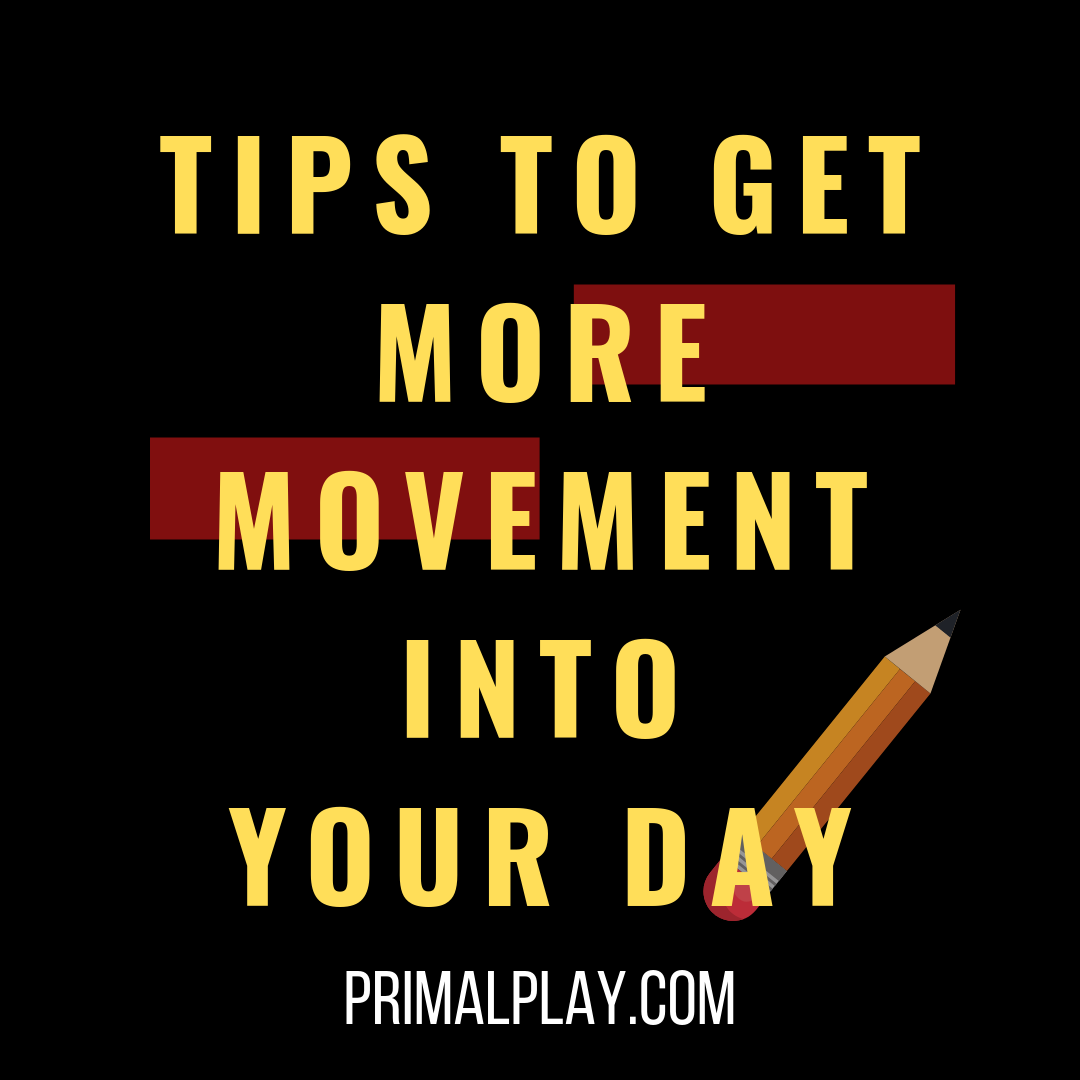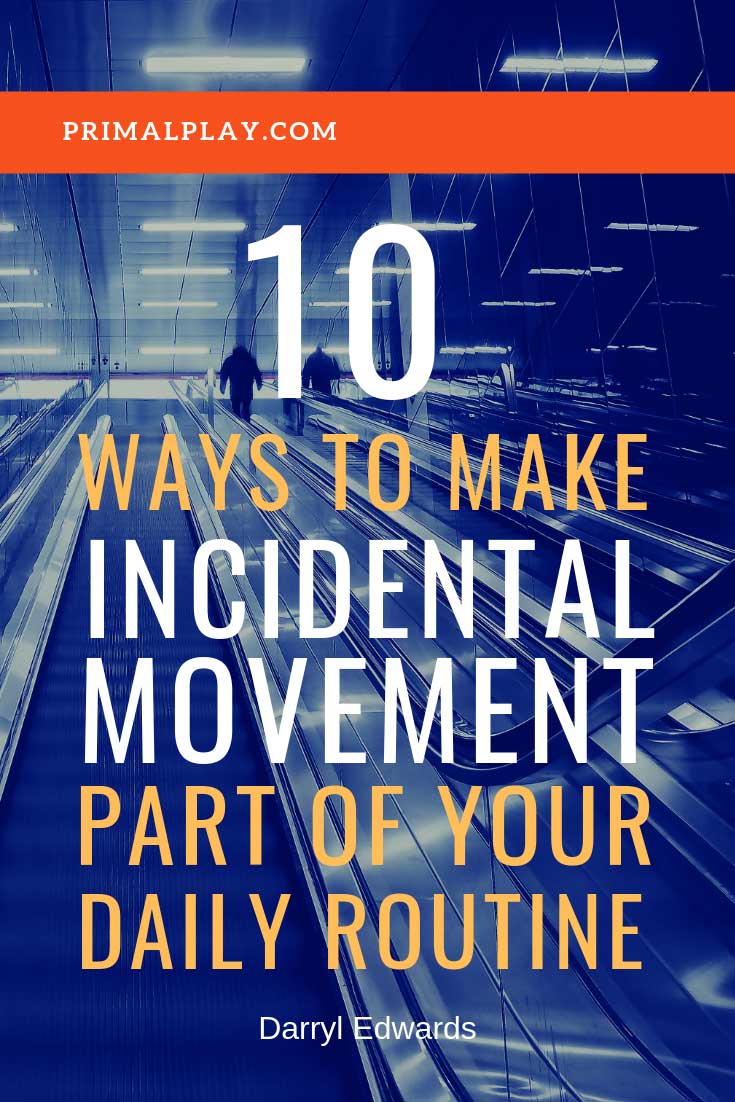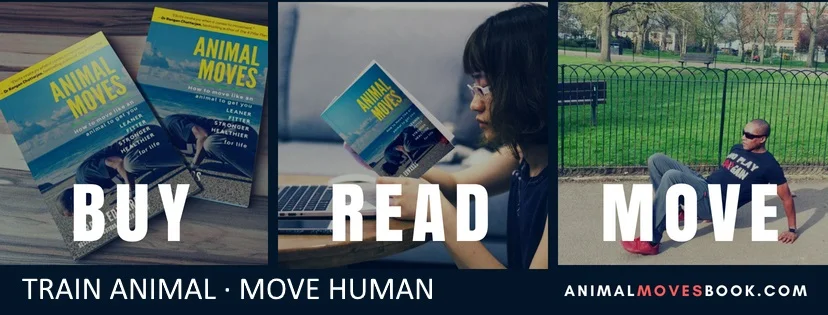10 Ways To Make Incidental Physical Activity Part of Your Daily Routine
““The Development of the Mind Comes Through Movement””
Movement Snacks - Move More, More Often.
It's no surprise that a sedentary lifestyle, one potential side effect of 21st-century life for the modern Homo-sapiens, can seriously compromise well-being and inactivity can fuel many chronic health conditions. But even with constant messages telling us how great movement is for physical and mental health it can be difficult to take our daily medicine.
For the past decade, the evidence has continued to mount that leading a sedentary lifestyle comes with some potentially adverse health effects. For example, sitting for most of the day can increase your risk of fat gain and obesity [1], raise your blood sugar levels [2] and decrease insulin sensitivity [3] as well as increase your risk of heart disease.[4]
The most alarming statistic? People who sit still more than 4 hours per day have a 40 per cent higher risk of premature death than those that sit fewer than four hours per day. [5]
What can we do to get sufficient amounts of physical activity to make a difference to our health? In a study looking at minimal-intensity physical activity, [4] the researchers concluded that:
"One hour of daily physical exercise cannot compensate for the negative effects of inactivity on insulin level and plasma lipids if the rest of the day is spent sitting. Reducing inactivity by increasing the time spent walking/standing is more effective than one hour of physical exercise when energy expenditure is kept constant." [4]
If we rely on exercise as our primary source of physical activity there are two potential problems we may encounter:
We may engage in vigorous movement for 30 minutes daily, but then avoid movement for the rest of the day. In other words, they engage in something I term "movement fasting".
We may not have enough time in our day to squeeze in a workout after all the things we need to do. After all, we sit on the commute to and from work, mostly sit at work, and then return home to sit at home watching TV or browsing the net on our smart devices.
Being “too busy” or “not having enough time” is no excuse for not prioritising a movement regimen. That’s because you can make incidental movement—the type of movement you get from simple daily physical activities—a core part of your daily fitness activity. Movement snacks or exercise snacks can make physical activity requirements more palatable.
Getting frequent bouts of LISS, “low-intensity, steady-state” exercise such as walking, additional NEAT, “non-exercise activity thermogenesis” and brief periods of HIIPA, “high-intensity, incidental physical activity”, [17] is one way to get there.
So if the idea of going to the gym is off-putting, or you struggle for time then keep reading for 10 practical ways to make incidental exercise part of your fitness routine.
““People who sit still more than 4 hours per day have a 40 per cent higher risk of premature death than those that sit fewer than four hours per day.””
Here's a few ways to get your HIIPA movement in!
#1: Use your lunch break to squeeze in a brisk walk
It might be tempting to order food delivery, especially if the weather outside is dreary or cold, but you should look for every opportunity to make your lunch-break time work for you by incorporating 10 or 20 minutes of activity. Plan for takeout rather than eating at your desk. Better yet, bring your prepared lunch from home, eat relatively quickly, and spend the rest of your lunch break taking a walk.
Research suggests that a short walk after your meal is a great way to reduce blood sugar levels. [6][7][8]
Walking to and from the local deli can be a great fitness break in the middle of the day too, and you’ll just fell better than sitting at your desk all day.
#2: Climb the stairs
Ignore elevators and escalators when you can, especially when walking upstairs. Walking up a set of stairs is more intense than stepping down and burns around four times as many calories. If you work in a tall office building, it might not feel practical to walk up all those flights of stairs, so get off a few floors earlier and then walk the rest of the way. Even low volumes of stair climbing can increase your cardiovascular fitness [9] and you can make it HIIPA by running up a flight or too.
#3: Park your car at the edge of a car park
You might be in the habit of parking as close as possible to a store or office building, but try leaving your car on the edge of the car park instead. Even better take the stairs in a multi-storey car park. You’ll force yourself to walk an extra few minutes getting to and from your car.
If you take the bus or metro to work, stand as often as possible and get off a few stops earlier to add additional walking time. This extra walking adds up - walking for as little as 60 minutes week has been shown to reduce heart disease risk in women. [10]
#4: Make a performance of turning housework into a workout
If you’ve been putting off cleaning your home, you can now kill two birds with the same stone. Put on some energetic, upbeat music, and clean your home. Just vacuuming a few rooms of your house and cleaning some hard-to-reach spots (go low, go high) can make for a brief, inspired full body HIIPA workout - even better use a broom instead it will make you work harder and get all the household involved to make it a social occasion. Music also acts as a distraction, improves the mood and makes you feel as if you are physically doing less. [11]
#5: Do yard work outdoors
You don’t have to do all your incidental exercise indoors. Try going outside to take care of chores like mowing the lawn, washing your car or raking leaves. Gardening can be a good source of physical activity; just ditch the machinery and do as much as you can manually. There is significant evidence for the positive benefits of gardening on physical, psychological, and social health and not just for older adults either. [12][13]
#6: Walk your dog
Man’s best friend can inspire you to get outdoors and move more. Dog owners tend to walk more too and get more minutes of total physical activity per week than non-owners also, over and above dog-walking - so a great incentive to move more. [14]
If you walk your dog in the morning and evening, you get in two short rounds of incidental movement. And instead of just walking, why not make it more intense by playing chase with your dog instead?
RELATED: Have fun with fitness
#7: Walk to the store
In the year 2000, we were walking an average of eight miles less each day than our ancestors of 50 years previously. [15] It’s tempting to hop in the car, even for an errand that is just around the corner. Instead, why not try walking to the store or supermarket? Bonus: there's some excellent resistance work involved in carrying all those goodies back home too.
#8: Get up, Stand Up
Most likely, you are sitting far too much during the day. As a rule of thumb, you should be getting up every 20-30 minutes and moving around. Knock out a few squats, take a few flights of stairs for a minute or two, or try an Animal Moves Deck card as a quick movement snack. Use a standing desk if you have that option or improvise and make your own.
Bonus Tip: Drinking plenty of water means you have to visit the toilet more frequently. Every time you need to visit the bathroom you have a reason to walk there and back. To take it up a notch, use a toilet in another part of the building, which may give you an opportunity to use the stairs as well.
#9: Move As You Talk
It’s tempting to sit in a comfortable chair or on the couch while making a call, but try moving around as you talk. Just walk from one room of your home to another. Breaking up inactivity is the key. It’s an easy way to turn a 5-minute phone call into a 5-minute 'walk-out' routine. Get your colleagues involved by hosting standing meetings or even better walking meetings as frequently as possible.
This is another great way to get more activity in without even noticing that it’s happening.
RELATED: How To Do A Bodyweight Squat
#10: Turn TV time into a mini-workout
You don’t have to sit on the couch while watching TV to enjoy it. If you’re watching a sporting event, try sprinting in place during commercials. If you’re watching a drama, do one rep of an exercise every time a key character appears. Then do one rep of a different activity when they leave the scene. If you want to game things up then try the Animal Moves Deck to randomise the activities you do based on Animal Move Workouts.
===
If the thought of squeezing in a 30-minute workout session into your busy schedule sounds impossible, you might be surprised at how you can get a similar 30-minutes of purposeful movement into your day without it feeling like a chore. The “No Pain, No Gain” mantra often associated with exercise isn’t compelling enough to get many of us to move more - even with the known health benefits.[16]
Take advantage of movement snacks and avoid sedentary convenience throughout the day. These are only a few examples but they illustrate that movement snacks don’t take up much time but cumulatively they do add up to make a difference. The length of each bout of incidental physical activity can vary from a few seconds running up a flight of stairs to longer periods, for example, your daily commute. Give it a try, and good luck with your incidental movement lifestyle.
There's no such thing as too much snacking when it comes to movement!
RELATED POSTS:
References:
[1] Shoham N, Gottlieb R, Sharabani-Yosef O, Zaretsky U, Benayahu D, et al. "Static Mechanical Stretching Accelerates Lipid Production in 3T3-L1 Adipocytes by Activating the MEK Signaling Pathway" American Journal of Physiology-Cell Physiology 302.2 (15 January 2012): C429-C441. doi: 10.1152/ ajpcell.00167.2011
[2] Owen N, Healy GN, Matthews CE, Dunstan DW. “Too much sitting: the population health science of sedentary behavior” Exercise and sport sciences reviews vol. 38,3 (July 2010): 105-13. doi: 10.1097/JES.Ob013e3181e373a2
[3] Healy GN, Dunstan DW, Salmon J, Cerin E, Shaw JE, et al. "Objectively measured light-intensity physical activity is independently associated with 2-h plasma glucose." Diabetes Care. (Jun 2007) : 1384-9. doi: 10.2337/dc07-0114
[4] Duvivier BM, Schaper NC, Bremers MA, van Crombrugge G, Menheere PP, et al. "Minimal Intensity Physical Activity (Standing and Walking) of Longer Duration Improves Insulin Action and Plasma Lipids More than Shorter Periods of Moderate to Vigorous Exercise (Cycling) in Sedentary Subjects When Energy Expenditure Is Comparable." PLoS ONE 8.2 (2013): e55542. doi: 10.1371/ l.pone.0055542
[5] Dunstan DW, Owen N., (2012), Arch Intern Med."New Exercise Prescription: Don't Just Sit There: Stand Up and Move More, More Often." Arch Intern Med 172.6 (26 March 2012): 500-1. doi: 10.1001/archinternmed.2012.209
[6] Reynolds AN, Mann JI, Sheila Williams S, et al. "Advice to walk after meals is more effective for lowering postprandial glycaemia in type 2 diabetes mellitus than advice that does not specify timing: a randomised crossover study" Diabetologia (2016) 59: 2572.
[7] Heden TD, Winn NC, Mari A et al. (2015) "Post-dinner resistance exercise improves postprandial risk factors more effectively than predinner resistance exercise in patients with type 2 diabetes." J Appl Physiol 118:624–634 J Appl Physiol (1985). 2015 Mar 1;118(5):624-34. doi: 10.1152/japplphysiol.00917.2014. Epub 2014 Dec 24.
[8] Larsen J, Dela F, Kjær M, Galbo H (1997) "The effect of moderate exercise on postprandial glucose homeostasis in NIDDM patients." Diabetologia 40:447–453 ()
[9] Kennedy, Rodney A et al. “Evaluating the effects of a low volume stairclimbing programme on measures of health-related fitness in sedentary office workers” Journal of sports science & medicine vol. 6,4 448-54. 1 Dec. 2007
[10] Lee IM, Rexrode KM, Cook NR, Manson JE, Buring JE "Physical activity and coronary heart disease in women: is "no pain, no gain" passé?" JAMA. 2001 Mar 21;285(11):1447-54.
[11] Karageorghis, Costas I and David-Lee Priest. “Music in the exercise domain: a review and synthesis (Part I)” International review of sport and exercise psychology vol. 5,1 (2011): 44-66. https://dx.doi.org/10.1080%2F1750984X.2011.631026
[12] Soga, Masashi et al. “Gardening is beneficial for health: A meta-analysis” Preventive medicine reports vol. 5 92-99. 14 Nov. 2016, doi:10.1016/j.pmedr.2016.11.007
[13] Wang D., MacMillan T. "The benefits of gardening for older adults: a systematic review of the literature." Act. Adapt. Aging. 2013;37:153–181.
[14] Cutt, Hayley et al. “Understanding dog owners' increased levels of physical activity: results from RESIDE” American journal of public health vol. 98,1 (2008): 66-9.
[15] Carnall, D. “Cycling and health promotion. A safer, slower urban road environment is the key” BMJ (Clinical research ed.) vol. 320,7239 (2000): 888.
[16] Edwards, Darryl (2019) "No Play No Gain: Is Exercise as Medicine too Bitter a Pill to Swallow?" Journal of Evolution and Health: Vol. 3: Iss. 1, Article 7. https://doi.org/10.15310/2334-3591.1108
[17] Stamatakis E, Johnson NA, Powell L, et al "Short and sporadic bouts in the 2018 US physical activity guidelines: is high-intensity incidental physical activity the new HIIT?" Br J Sports Med Published Online First: 20 February 2019. doi: 10.1136/bjsports-2018-100397Get your copy of the best-selling book Animal Moves










